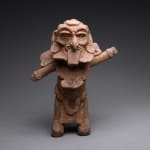Toltec Terracotta Warrior, 900 AD to 1200 AD
Terracotta
19.1 x 14 cm
7 1/2 x 5 1/2 in
7 1/2 x 5 1/2 in
PH.0280
Further images
The Toltec civilization first gained ascendancy in the Valley of Mexico around 900 A.D., after the fall of Teotihuacan. Although their origins and early history are obscure, the Toltecs appear...
The Toltec civilization first gained ascendancy in the Valley of Mexico around 900 A.D., after the fall of Teotihuacan. Although their origins and early history are obscure, the Toltecs appear to have ancient ties to both the Mixtec and the Zapotec. The word Toltec means “master builders’ in the Nahuatl language, a testament to the sophistication of Toltec constructions. Their art and architecture was highly influenced by Teotihuacan as well as the ancient Olmec culture. The Toltecs were technologically advanced, capable of smelting metals. Their stonework was impeccable as the ruins of Tula demonstrate. This archaeological site is believed to be Tollan, the legendary capital of the Toltec civilization referred to in a number of postconquest sources. Their social structure was headed by an elite class of warriors. Excavations have uncovered the ceremonial center that included a pyramid structure topped by a temple dedicated to the hero-god Quetzalcoatl.
This sculpture of a warrior is unique in its style and level of detail. This figure of a warrior alludes to the Toltec society of this ancient period, which was largely a warrior culture. Many skilled craftsmen created objects like this that reveal their impressive artistic practices. Overall, this is a quintessential work of art by the Toltecs that is highly valuable, especially since much of Toltec artistic history has been lost due to destruction.
This sculpture of a warrior is unique in its style and level of detail. This figure of a warrior alludes to the Toltec society of this ancient period, which was largely a warrior culture. Many skilled craftsmen created objects like this that reveal their impressive artistic practices. Overall, this is a quintessential work of art by the Toltecs that is highly valuable, especially since much of Toltec artistic history has been lost due to destruction.







